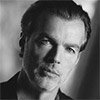Mark Martin shouldn't be flying around Darlington and Talladega for four hours at speeds up to 200 miles per hour. Not at age 53. Not after having not one, but two of the disk spaces in his back blow out, requiring lumbar fusion surgery in 1999. Not with his 5-foot-5, 125-pound body baking in the cockpit at 120 degrees and pulling 3 g on turns, similar to what astronauts experienced during shuttle launches—except that those pilots didn't have vehicles rocketing equally fast just inches away.
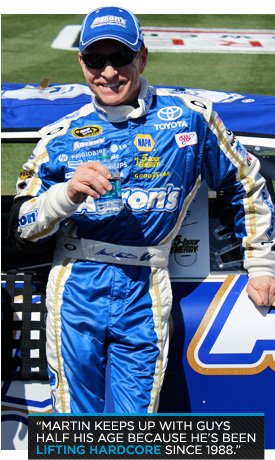
Conventional wisdom says NASCAR drivers hit their peak between ages 26 and 35. During this decade, they generally have some experience under their seatbelt, but their eyes and reflexes are still at their sharpest. So how does Martin keep up with guys half his age? He says he's still racing in 2012 in part because he's been lifting hardcore since 1988. He may weigh 125 pounds, but with just 6 percent body fat, Martin has managed to shoehorn a lot of muscle onto one of the slightest frames in his sport.
No one else Martin's age does what he does. It's just him out there, beating younger men and flipping Father Time the bird after a few victory doughnuts. He knows he needs every edge he can get, which is why earlier this year he decided to rev up his fitness by taking on the aptly named "Shortcut to Size," Jim Stoppani, Ph.D.,'s 12-week muscle-gain gauntlet on Bodybuiding.com. Now he's moving on to the sequel, which we'll be publishing in the coming months.
I had the privilege to catch up with this racing legend shortly before he wrapped up his incredible 30th NASCAR racing season. He told me how going pedal to the metal in the gym helps him do the same on the oval, and how fitness has helped him achieve the incredible feat of never missing a race due to injury—even after having back fusion surgery, which usually demands a year of recovery.
Mark Martin: I had been following another workout program since January 2009, and I had reached a plateau. I saw Shortcut to Size on your website and thought it would be an awesome change from what I had been doing. I was right. My intensity was very, very high on this program. I trained very hard. It's pretty damn tough to put on any more muscle at 53 years old, when you have been slinging iron for 25 years. They tell me it normally doesn't happen. But in this case, it did.
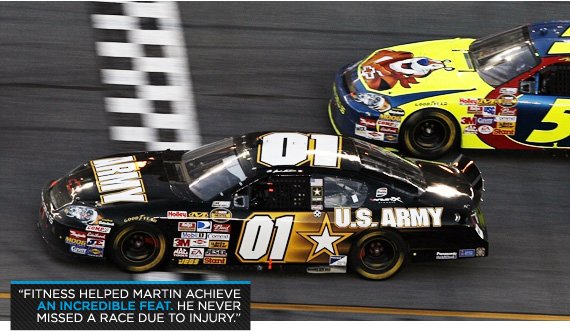
I was able to make strength gains and blow through some plateaus on a lot of different exercises. I hadn't seen that kind of progress in years and years.
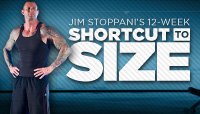
- Dr. Jim Stoppani helps you build muscle faster than ever!
- Science-backed 12-week program produces extreme results.
- Build muscle and gain strength with Jim's exclusive tips.
One of the reasons my legs were laggards was that I had a horrendous bout with plantar fasciitis, and I was unable to squat and do serious heavy lifting with my legs for a couple years. I could only do leg extensions and leg presses. I began doing Smith machine squats and made some gains doing those, but last October [2011], I began doing barbell deadlifts and squats. I hadn't done squats in nearly 20 years because of a degenerating disk, which had led to years of pain and misery. I had a fusion in 1999 and only did leg presses and extensions until October of 2011. So I'm thrilled and excited to be deadlifting, and doing well with that, and to be squatting.
It is the best it has been since the surgery. I never got strong because I was always afraid to try to do too much with it, so I never really trained it. When I started deadlifting, I used 65 pounds, and I was nervous because I felt like it was pushing it. Yesterday, I did 180 for 10 reps, and that's pretty cool. You don't see that kind of progress very often when you are an experienced trainee. I feel better and more confident now then when I started out.

I probably wasn't squatting with great form, but before the surgery I could bench 230 pounds. I can't do those kinds of numbers anymore, but I can 205 with good form, which to me is awesome. My back really only began getting better when I started aggressively strength training.
Yeah, in my early training days I used poor form a lot and didn't listen to my body, and only went for the weight numbers. Now I'm very conscious of form and injury. I went through so many years in pain that I decided to really paying a lot more attention to form and not slinging quite as much weight. I tore a rotator cuff benching heavy back in the early 1990s, and I never had it repaired, so I don't throw up impressive numbers on the bench press anymore.
When I first started lifting, I switched from greasy food to grilled chicken and fish and some vegetables. But I still ate too many processed foods because as NASCAR drivers, we eat on the run an awful lot. I still ate a lot of turkey sandwiches on wheat bread with mustard and Baked Lay's potato chips—which is better than some things, but not as good as grilled fish, fresh vegetables and a sweet potato.
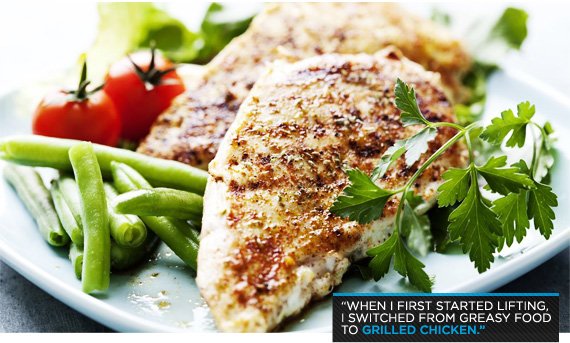
Every time I had ever tried to put weight on, my waist got bigger, and that's not what I wanted to grow. So recently I decided to let my belt go out a notch to see what happened if I added calories in the form of quality foods: egg whites, a lot of nuts, oatmeal, lots of fresh vegetables and some fruit. I decided I would give it a whirl.
I thought a couple hundred extra calories a day would be enough to gain size, but after four weeks, I didn't see nothin'. That kind of irritated me, so I ramped it up to 300 extra calories a day, and I am going to keep going until I see something happen. I even swore off cardio until I see some gains. I said, "Dagnabbit, I'm going to give the cardio up until I gain a little weight here and then get back on my cardio program."
I keep Calorie Smart on my phone and I've logged everything I've eaten every day for three years. My daily intake is about 2,500 calories now, up from about 2,200. Some days it goes over, some days I fall a little short, but I'm averaging about 2,500. I'm probably about 5-foot-5 and 125 pounds at best. I'm a pretty little guy but I have a lot of enthusiasm and passion for training and eating healthy.
Racing in the Groove

Name: Mark Martin
Location: Daytona Beach, Florida
Born: January 9, 1959, in Batesville, Arkansas
Current Affiliations
NASCAR Sprint Cup Racing Series
Sponsor: Aaron's Dream Machine
Manufacturer: Toyota
Car Owner: Bill Jenkins
Team: Michael Waltrip Racing (Raced for Jack Roush from 1988-2006)
Crew Chief: Rodney Childers
Career Victories (Top 10 finishes):
NASCAR Sprint Cup Series: 40 (448)
NASCAR Nationwide Series: 49 (152)
NASCAR Camping World Truck Series: 7 (20)
Career Season Titles:
American Speed Association: 1978-80, 86
IROC: 94, 96-98, 05
NASCAR Sprint Cup: 5-time Runner-up (90, 94, 98, 00, 09)
Career Winnings: $65,768,280
Awards:
2009 Person of the Year, by NASCAR Illustrated
2009 Dale Earnhardt Tough Driver Award
1977 ASA National Tour Rookie of the Year
NASCAR's 50 Greatest Drivers
Twitter: @55markmartin
Car Away From The Track: I drive a Lexus ISF. The "F" makes it a hotrod. I don't have any muscle cars or tricked out anything. I love this car.
Favorite Road Trip: The trip from the house to the airport. I've got a private jet and I actually fly it myself.
I don't do specific training for driving, but every driver is different. Some are big boys who weigh 225, and if I were them I would tailor my program around cardio. I'm a little guy, so my passion is training for strength and stamina. I have built quite a bit of endurance because I take 60 to 80 seconds between my sets. No jacking around, talking, and goofing off. When I train, I breathe. When I put the weight down, I breathe. I don't want to talk. I don't want a bunch of gabbing.
They don't understand because they can't comprehend that the cockpit of a racecar ranges from 110 up to 130 degrees, depending on the outside temperature, and you're in there for four hours. If you drive the car slow, it's easy. If you drive it as fast as it will go, it's a little harder. But every single one of us drives the car faster than it will go, if you know what I mean.
Only your talent and your ability to wrestle the car, fight the steering wheel, work the pedals, and all those things limit you. No one gets that part. Driving a racecar is easy as long as you don't start trying to take it beyond its abilities.
You do today. It is so competitive that every driver is doing that, and that's what really makes it hard. I've always said that if I'm not tired after the race, I didn't drive hard enough. That's where the training underpins my success. If I've got 50 cents, I need to spend 50 cents. But if I've got 60 cents, I don't need to stop at 50. So the only limit for me is how much strength and stamina I can add to this program to support my level of my talent. I've got to push to the extremes of my talent and my physical and mental ability.
Experience is very, very important—not just practicing driving, but deciding how to handle every situation. I'm not bragging, but the fact is that I'm 53 years old and I'm able to do this competitively. I've won four pole positions this year, finished second and third, and been very competitive in a young man's game.
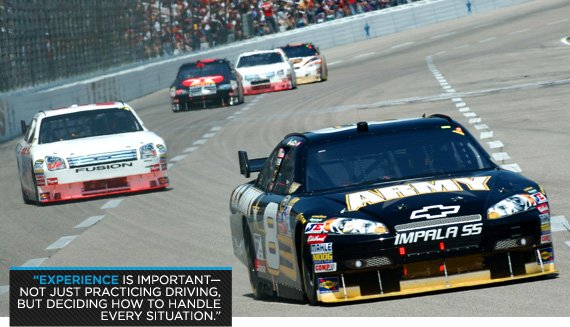
I'm known in the NASCAR circles as being the workout guy. When I started in 1988, lifting wasn't common in racing. Some guys did it, but nothing major. Today, training is common. Some do strength training, some do more stamina work, some are into CrossFit—you name it. Once one guy starts doing it, if you want to compete, you need to be doing it. You can't let someone else build an advantage.
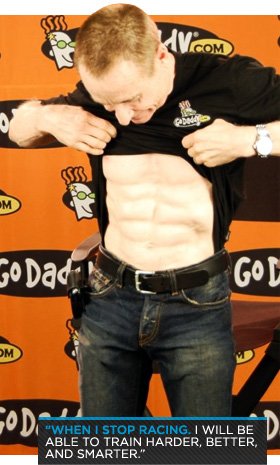
There is no question in my mind that my longevity has been influenced by my commitment to fitness. Also, in my younger years—when the cars weren't as safe and there weren't as good of restraint systems in the car, and I hit a lot of concrete walls really hard—I certainly believe that it helped me avoid major injury in crashes by being in better condition. Being muscular and in condition helped a ton in a lot of those accidents for me. I have never had to miss a race.
The Home Stretch
I will actually train harder, better, and smarter when I stop racing. I will be able to have more control over the days that I can train, and I will have better control over my rest. I still have to tailor my training around the racing. The optimum training split, for example, I can't do. I've raced three weekends in a row now, and I have to train Monday, Tuesday, Wednesday, and Thursday. I used to train on Fridays and then drive the racecar, but not anymore. I could get stronger if I wasn't getting beaten down and dehydrated in the racecar.
For now, I race on Sunday, and I'm in the gym at 7 am on Monday morning, ready to hit back and biceps. I always do back and bis the day after my race, because back is my strong suit. I can still do it 100 percent even when I'm dehydrated and run down. I couldn't go in and squat 200 pounds first thing Monday morning after racing 500 miles in the sweltering heat the day before.
At the racetrack, there is a lighted score board that they put the car numbers on. Seeing my number go to the top of the score board ... there is no feeling like it. Nothing. And then driving into the garage and seeing the faces of my team, the guys who do all the work. The excitement and the enthusiasm—that's incredible. I hope to replace that with training those guys so they can go over the pit wall and be the fastest crews on pit row. That will be cool, too.
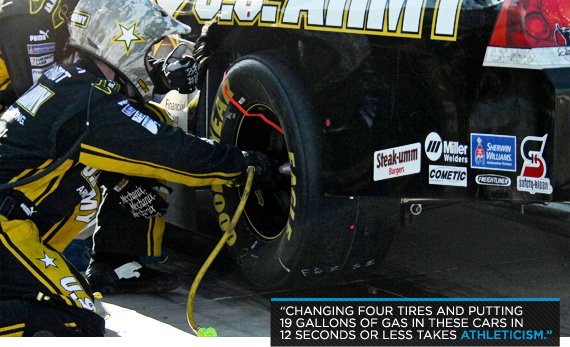
Fitness. The pit crews are changing four tires and putting 19 gallons of gas in these cars in 12 seconds or less, and they all train like athletes, doing CrossFit and stuff. I'm spending more and more time with them because I relate to them. We're actually recruiting a lot of college athletes now and teaching them how to pit these cars. If you have never seen a pit stop you need to bring one up on the Internet and watch one of these things. It is absolutely amazing.




